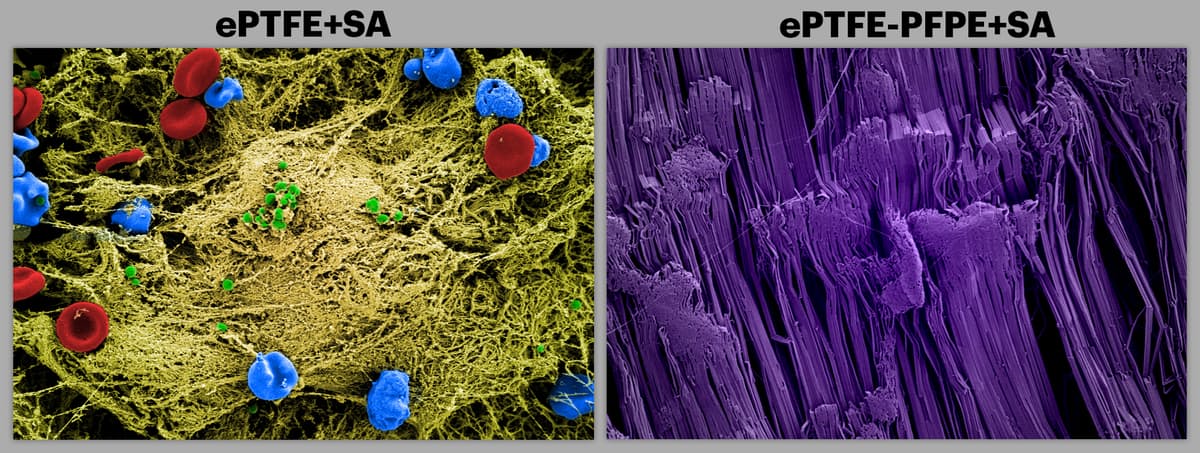
The SEM image on the left shows a commonly used teflon surface implanted into mice that were infected with S. aureus. The unmodified device surface attracted the infectious bacteria (green). Red blood cells (red), immune cells (blue), and extracellular matrix material (yellow) are also shown to deposit on the surface. The SEM image on the right (colored purple) is of the same teflon surface treated with SLIPS within the infected mice. It shows no adhesion of cells or deposition of extracellular matrix material. Credit: Wyss Institute at Harvard University
Implanted medical devices such as left ventricular-assist devices for patients with heart failure or other support systems for patients with respiratory, liver or other end organ disease save lives every day. However, bacteria that form infectious biofilms on those devices, called device-associated infections, not only often sabotage their success but also contribute to the rampant increase in antibiotic resistance currently seen in hospitals.
As reported in Biomaterials, a team led by Joanna Aizenberg, Ph.D., and Elliot Chaikof, M.D., Ph.D., at the Wyss Institute for Biologically Inspired Engineering and the Harvard John A. Paulson School of Engineering and Applied Sciences at Harvard University (SEAS), as well as the Beth Israel Deaconess Medical Center (BIDMC), has created self-healing slippery surface coatings with medical-grade teflon materials and liquids that prevent biofilm formation on medical implants while preserving normal innate immune responses against pathogenic bacteria.
The technology is based on the concept of ‘slippery liquid-infused porous surfaces’ (SLIPS) developed by Aizenberg, who is a Wyss Institute Core Faculty member, Professor of Chemistry and Chemical Biology and the Amy Smith Berylson Professor of Materials Science at SEAS. Inspired by the carnivorous Nepenthes pitcher plant, which uses the porous surface of its leaves to immobilize a layer of liquid water, creating a slippery surface for capturing insects, Aizenberg previously engineered industrial and medical surface coatings that are able to repel unwanted substances as diverse as ice, crude oil and biological materials.
“We are developing SLIPS recipes for a variety of medical applications by working with different medical-grade materials, tuning the chemical and physical features of these solids and the infused lubricants to ensure the stability of the coating, and carefully pairing the non-fouling properties of the integrated SLIPS materials to specific disturbing factors, contaminating environments and performance requirements,” said Aizenberg. “Here we have extended our repertoire of materials classes and applied the SLIPS concept very convincingly to medical-grade teflon, demonstrating its enormous potential in implanted devices prone to bacterial fouling and infection.”
First, the team searched ex vivo for the teflon material that would work best with a selection of compatible lubricants to provide a long-lived repellent surface against a common device-associated bacterial strain. The most advantageous teflon-lubricant combinations had to preserve the anti-bacterial activity of innate immune cells that provide the natural first-line response against invading bacteria. The winning material was ‘expanded polytetrafluoroethylene’ (ePTFE). Used in prosthetic grafts for cardiovascular reconstruction, mesh for hernia repair, as well as implants in a wide variety of reconstructive surgery, ePTFE tested well with lubricants with proven acceptable safety profiles.
Moving to a rodent model, the team compared bacterial and tissue responses to implanted hernia meshes with or without a SLIPS surface after infecting the animals with Staphylococcus aureus.
“SLIPS coatings yielded extremely favorable responses in vivo: they resisted infection by bacteria and were associated with considerably less infiltrating immune cells and inflammatory abscesses than non-coated ePTFE,” said Chaikof, who is a Wyss Institute Associate Faculty member, Chairman of the Roberta and Stephen R. Weiner Department of Surgery and Surgeon-in-Chief at BIDMC.
“At present, patients who receive implants for the repair, reconstruction or replacement of diseased or damaged organs or tissues or otherwise depend upon temporary life sustaining support systems, often require antibiotics at the time of implantation to keep the risk of bacterial infection at bay. SLIPS coatings one day could obviate the widespread use of antibiotics, minimize the development of antibiotic resistant microorganisms, and enhance the capacity of temporary or permanent artificial devices to resist infection,” said Chaikof.
“This new study by Joanna and Elliot exemplifies the Wyss Institute model in which collaborations between basic scientists focused on industrial applications and clinicians working in the medical area are fostered in a way that can lead to unexpected developments — in this case, one that has the potential to have a major positive impact in the clinical setting,” said Don Ingber, M.D., Ph.D., Founding Director of the Wyss Institute, Judah Folkman Professor of Vascular Biology at Harvard Medical School and Boston Children’s Hospital, and Professor of Bioengineering at SEAS.
Previous medical SLIPS applications include coatings that can repel bacteria and blood from small medical implants, tools and surgical instruments that are made of steel or, more recently, coatings that help keep the glass surfaces of endoscopy and bronchoscopy lenses free from highly contaminating body fluids and thus transparent during procedures.




